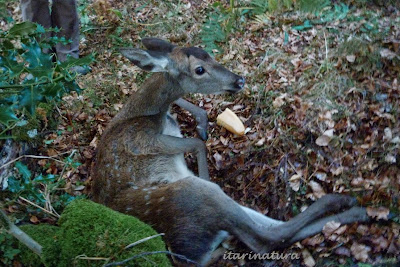 |
| Pinguícula/waterworts(Pinguícula grandiflora) |
In the forest of Irati Aezkoa Valley, we have two kinds of carnivorous plants. The you see in the picture is the
Pinguicula or waterworts (Pinguicula grandiflora) which is now in flower.
The black dots on the green leaves are small insects that got stuck in the leaves due to a secretion of mucilage (a sticky substance also found in the fruits of mistletoe formerly used as glue underpowered).
When the unfortunate creature is stuck, begins to secrete a kind of enzymes that act as digestive system in the outside.
It's their way of to get mainly nitrogen, in areas where the soil is very poor in it.
I always see in areas of runoff water or light build. Zones and PH very acid washed, such as bogs or bogs in formation areas, of which we have some in
the Irati of Aezkoa valley(Navarre)
 |
| Common sundew(Drosera Rotundifolia) |
The other plant we have is more special, and spend more unnoticed. With less than 5 centimeters, is a little bit like carnivorous plant that we have in mind, and which sold in stores a tropical species, bigger than ours.
It is the common sundew(Drosera rotundifolia). In Mediterranean areas as Izki Natural Park (Araba, Baasque country) can be found G
reat sundew(
Drosera/anglica longuifolia) species, which as its latin name suggests, has longer leaves.
In the high-Azpegi, in the westernmost part of Irati have peaty ecosystems (peat forming) one of which recently closed with wooden fencing to prevent livestock can step flora before flowering. The idea is that once this has happend, we can open three wickets for the free entrance of the cattle.
It so happens that cattle trampling those plants, is at the same time preventing the growth of others, such as Gorse (Ulex europaea) that could be cause problems in this ecosystem, but also is the responsible to create small wells with their hooves in the mud, where they later leave the most interesting plants
 |
| Etzangio Board (Azpegi summit/ Aezkoa) in front the bog. |
This is the panel explaining the pre-bog ecosystem, developed by us(
Itarinatura) recently.
A peatland is a zone with constant supply of water where they grow mainly
Sphagnum and other mosses, along with other plants associated with that ecosystem.
Over time, new mosses grow on top of the dead, that having low oxygen just rot, and over the years we may have a depth of several meters of peat, which is the type of substrate that you can find in garden stores.
Almost all of Ireland or Scotland is full of such areas as well as large areas of the Pyrenees, where the soil remains waterlogged environment. In these countries cut peat in portions to use as fuel, because long time ago that the great forests disappeared, at least as to get firewood. Literally they burn the ground in fireplaces, and what's left later in these sites is the bedrock sterile because the peat is formed in a slow process of thousands of years.
Among other types of wildlife and vegetation can talk about dragonflies, spiders that eat dragonflies, others that they eat other spiders and dragonflies, if they can, ..
Typical of these ecosystems is the
Common cotton grass (Eriphorum angustifolium), a type of rush Shaggy has not still taken the flower. Certain types of orchids and daffodils,mayflowers,gentians,..too.
 |
| Common cotton grass(Eriophorum angustifolium) |
 |
| Spider eating a butterfly |
At the peat bog are associated many amphibians like Common frog (Rana temporaria), the Salamander (Salamandra salamandra) webbed Triton (Lissotriton helveticus) or the common toad (Bufo bufo), which attract all kinds of predators. Difficult to see them, but not his tracks. In this way we see that badgers, foxes ,bobcats and European polecat approached those sites to hunt.
 |
| Common frogs(Rana temporaria) matting |
 |
| Salamander(Salamandra salamandra) |
 |
| Budger tracks(Meles meles) |
If you decide to visit this place, as always, be respectful (I know what you will, but you would not be on this page) with everything you see.




































1.jpg)

2.jpg)






















